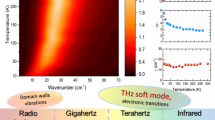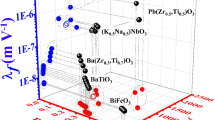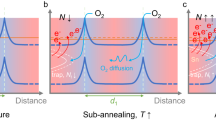Abstract
Epitaxial strain can unlock enhanced properties in oxide materials, but restricts substrate choice and maximum film thickness, above which lattice relaxation and property degradation occur. Here we employ a chemical alternative to epitaxial strain by providing targeted chemical pressure, distinct from random doping, to induce a ferroelectric instability with the strategic introduction of barium into today’s best millimetre-wave tuneable dielectric, the epitaxially strained 50-nm-thick n = 6 (SrTiO3)nSrO Ruddlesden–Popper dielectric grown on (110) DyScO3. The defect mitigating nature of (SrTiO3)nSrO results in unprecedented low loss at frequencies up to 125 GHz. No barium-containing Ruddlesden–Popper titanates are known, but the resulting atomically engineered superlattice material, (SrTiO3)n−m(BaTiO3)mSrO, enables low-loss, tuneable dielectric properties to be achieved with lower epitaxial strain and a 200% improvement in the figure of merit at commercially relevant millimetre-wave frequencies. As tuneable dielectrics are key constituents of emerging millimetre-wave high-frequency devices in telecommunications, our findings could lead to higher performance adaptive and reconfigurable electronics at these frequencies.
This is a preview of subscription content, access via your institution
Access options
Access Nature and 54 other Nature Portfolio journals
Get Nature+, our best-value online-access subscription
$29.99 / 30 days
cancel any time
Subscribe to this journal
Receive 12 print issues and online access
$259.00 per year
only $21.58 per issue
Buy this article
- Purchase on Springer Link
- Instant access to full article PDF
Prices may be subject to local taxes which are calculated during checkout




Similar content being viewed by others
Data availability
Figure data, DFT files and additional information can be accessed on the NIST Public Data Repository via the following link: https://doi.org/10.18434/M31968.
References
Tagantsev, A. K., Sherman, V. O., Astafiev, K. F., Venkatesh, J. & Setter, N. Ferroelectric materials for microwave tunable applications. J. Electroceram. 11, 5–66 (2003).
Bao, P., Jackson, T. J., Wang, X. & Lancaster, M. J. Barium strontium titanate thin film varactors for room temperature microwave device applications. J. Phys. D. 41, 063001 (2008).
Gevorgian, S. Ferroelectrics in Microwave Devices, Circuits and Systems: Physics, Modeling, Fabrication and Measurements (Springer, 2009).
Subramanyam, G. et al. Challenges and opportunities for multi-functional oxide thin films for voltage tunable radio frequency/microwave components. J. Appl. Phys. 114, 191301 (2013).
Meyers, C. J. G., Freeze, C. R., Stemmer, S. & York, R. A. (Ba,Sr)TiO3 tunable capacitors with RF commutation quality factors exceeding 6000. Appl. Phys. Lett. 109, 112902 (2016).
Vorobiev, A., Rundqvist, P., Khamchane, K. & Gevorgian, S. Microwave loss mechanisms in Ba0.25Sr0.75TiO3 thin film varactors. J. Appl. Phys. 96, 4642–4649 (2004).
Lee, C.-H. et al. Exploiting dimensionality and defect mitigation to create tunable microwave dielectrics. Nature 502, 532–536 (2013).
Ruddlesden, S. N. & Popper, P. New compounds of the K2NIF4 type. Acta Crystallogr. 10, 538–539 (1957).
Ruddlesden, S. N. & Popper, P. The compound Sr3Ti2O7 and its structure. Acta Crystallogr. 11, 54–55 (1958).
Tilley, R. J. D. Correlation between dielectric constant and defect structure of non-stoichiometric solids. Nature 269, 229–231 (1977).
Tilley, R. J. D. An electron microscope study of perovskite-related oxides in the Sr-Ti-O system. J. Solid State Chem. 21, 293–301 (1977).
Knott, L. J., Cockroft, N. J. & Wright, J. C. Site-selective spectroscopy of erbium-doped SrTiO3, Sr2TiO4, and Sr3Ti2O7. Phys. Rev. B. 51, 5649–5658 (1995).
Choi, K. J. et al. Enhancement of ferroelectricity in strained BaTiO3 thin films. Science 306, 1005–1009 (2004).
Béa, H. et al. Evidence for room-temperature multiferroicity in a compound with a giant axial ratio. Phys. Rev. Lett. 102, 217603 (2009).
Haislmaier, R. C. et al. Unleashing strain induced ferroelectricity in complex oxide thin films via precise stoichiometry control. Adv. Funct. Mater. 26, 7271–7279 (2016).
Wei, Y. et al. A rhombohedral ferroelectric phase in epitaxially strained Hf0.5Zr0.5O2 thin films. Nat. Mater. 17, 1095–1100 (2018).
Wood, C. E. C., Metze, G., Berry, J. & Eastman, L. F. Complex free-carrier profile synthesis by “atomic-plane” doping of MBE GaAs. J. Appl. Phys. 51, 383–387 (1980).
Schubert, E. F. Delta doping of III–V compound semiconductors: Fundamentals and device applications. J. Vac. Sci. Technol. A 8, 2980–2996 (1990).
Birol, T., Benedek, N. A. & Fennie, C. J. Interface control of emergent ferroic order in Ruddlesden–Popper Srn+1TinO3n+1. Phys. Rev. Lett. 107, 257602 (2011).
Neaton, J. B. & Rabe, K. M. Theory of polarization enhancement in epitaxial BaTiO3/SrTiO3 superlattices. Appl. Phys. Lett. 82, 1586–1588 (2003).
Tenne, D. A. et al. Probing nanoscale ferroelectricity by ultraviolet Raman spectroscopy. Science 313, 1614–1616 (2006).
Bland, J. A. The crystal structure of barium orthotitanate, Ba2TiO4. Acta Crystallogr. 14, 875–881 (1961).
Lee, S., Randall, C. A. & Liu, Z.-K. Modified phase diagram for the barium oxide–titanium dioxide system for the ferroelectric barium titanate. J. Am. Ceram. Soc. 90, 2589–2594 (2007).
Kwestroo, W. & Paping, H. A. M. The systems BaO-SrO-TiO2, BaO-CaO-TiO2, and SrO-CaO-TiO2. J. Am. Ceram. Soc. 42, 292–299 (1959).
Veličkov, B., Kahlenberg, V., Bertram, R. & Bernhagen, M. Crystal chemistry of GdScO3, DyScO3, SmScO3 and NdScO3. Z. Für. Krist 222, 466–473 (2007).
Xi, X. X. et al. Oxide thin films for tunable microwave devices. J. Electroceram. 4, 393–405 (2000).
Houzet, G., Burgnies, L., Velu, G., Carru, J.-C. & Lippens, D. Dispersion and loss of ferroelectric Ba0.5Sr0.5TiO3 thin films up to 110 GHz. Appl. Phys. Lett. 93, 053507 (2008).
Gu, Z. et al. Resonant domain-wall-enhanced tunable microwave ferroelectrics. Nature 560, 622–627 (2018).
Haeni, J. H., Theis, C. D. & Schlom, D. G. RHEED intensity oscillations for the stoichiometric growth of SrTiO3 thin films by reactive molecular beam epitaxy. J. Electroceram. 4, 385–391 (2000).
Haislmaier, R. C., Stone, G., Alem, N. & Engel-Herbert, R. Creating Ruddlesden–Popper phases by hybrid molecular beam epitaxy. Appl. Phys. Lett. 109, 043102 (2016).
Gevorgian, S. S., Martinsson, T., Linner, P. L. J. & Kollberg, E. L. CAD models for multilayered substrate interdigital capacitors. IEEE Trans. Microw. Theory Tech. 44, 896–904 (1996).
Kidner, N. J., Homrighaus, Z. J., Mason, T. O. & Garboczi, E. J. Modeling interdigital electrode structures for the dielectric characterization of electroceramic thin films. Thin Solid Films 496, 539–545 (2006).
Kresse, G. & Furthmüller, J. Efficient iterative schemes for ab initio total-energy calculations using a plane-wave basis set. Phys. Rev. B. 54, 11169–11186 (1996).
Kresse, G. & Joubert, D. From ultrasoft pseudopotentials to the projector augmented-wave method. Phys. Rev. B. 59, 1758–1775 (1999).
Perdew, J. P. et al. Restoring the density-gradient expansion for exchange in solids and surfaces. Phys. Rev. Lett. 100, 136406–136406 (2008).
Monkhorst, H. J. & Pack, J. D. Special points for Brillouin-zone integrations. Phys. Rev. B. 13, 5188–5192 (1976).
Togo, A. & Tanaka, I. First principles phonon calculations in materials science. Scr. Mater. 108, 1–5 (2015).
Togo, A. & Tanaka, I. Evolution of crystal structures in metallic elements. Phys. Rev. B. 87, 184104 (2013).
Stokes, H. T., Hatch, D. M. & Campbell, B. J. ISOTROPY Software Suite (Brigham Young University, 2015); https://stokes.byu.edu/iso/isotropy.php
Momma, K. & Izumi, F. VESTA 3 for three-dimensional visualization of crystal, volumetric and morphology data. J. Appl. Crystallogr. 44, 1272–1276 (2011).
Marks, R. B. A multiline method of network analyzer calibration. IEEE Trans. Microw. Theory Tech. 39, 1205–1215 (1991).
Williams, D. F., Wang, J. C. M. & Arz, U. An optimal vector-network analyzer calibration algorithm. IEEE Trans. Microw. Theory Tech. 51, 2391–2401 (2003).
Williams, D. F., Marks, R. B. & Davidson, A. Comparison of on-wafer calibrations. In Proc. 38th Automatic RF Techniques Group Conference Dig 68–81 (IEEE, 1991).
Orloff, N. D. et al. A compact variable-temperature broadband series-resistor calibration. IEEE Trans. Microw. Theory Tech. 59, 188–195 (2011).
Acknowledgements
The synthesis, characterization and theoretical work at Cornell was supported by the US Department of Energy, Office of Basic Sciences, Division of Materials Sciences and Engineering (Award no. DE-SC0002334). Sample preparation was in part facilitated by the Cornell NanoScale Facility, a member of the National Nanotechnology Coordinated Infrastructure (NNCI), which is supported by the National Science Foundation (grant no. NNCI-1542081). Ferroelectric and dielectric measurements with temperature were conducted at the Center for Nanophase Materials Sciences, which is a DOE Office of Science User Facility. Infrared and terahertz studies were supported by the Czech Science Foundation (project no. 18–09265S) and by the MŠMT (project no. SOLID21-CZ.02.1.01/0.0/0.0/16 019/0000760). This work made use of Cornell Center for Materials Research Shared Facilities, which are supported through the NSF MRSEC program (no. DMR-1719875). Certain commercial equipment, instruments or materials are identified in this article to specify the experimental procedure adequately. Usage of commercial products herein is for information only; it does not imply recommendation or endorsement by NIST, and it is not intended to imply that the materials or equipment identified are necessarily the best available for the purpose.
Author information
Authors and Affiliations
Contributions
N.M.D. and J.Z. synthesized the samples under the supervision of D.G.S. N.M.D. performed the ferroelectric and low frequency dielectric measurements versus temperature. G.H.O. performed the DFT calculations under the supervision of C.J.F. M.E.H. performed STEM measurements under the supervision of D.A.M. Millimetre-wave devices were fabricated and measured by E.J.M., A.M.H., X.L. and J.A.D. under the supervision of C.J.L., J.C.B. and N.D.O. R.U. and S.G. supplied the DyScO3 substrates. V.G. and C.K. performed the infrared and terahertz measurements under the supervision of S.K. N.M.D, D.G.S, E.J.M., A.M.H., N.D.O., G.H.O and M.E.H. wrote the manuscript. All authors discussed results and commented on the manuscript. The study was conceived and guided by D.G.S.
Corresponding author
Additional information
Publisher’s note Springer Nature remains neutral with regard to jurisdictional claims in published maps and institutional affiliations.
Supplementary information
Supplementary Information
Supplementary Discussion, Figs. 1–10, and Refs. 1–7.
Rights and permissions
About this article
Cite this article
Dawley, N.M., Marksz, E.J., Hagerstrom, A.M. et al. Targeted chemical pressure yields tuneable millimetre-wave dielectric. Nat. Mater. 19, 176–181 (2020). https://doi.org/10.1038/s41563-019-0564-4
Received:
Accepted:
Published:
Issue Date:
DOI: https://doi.org/10.1038/s41563-019-0564-4



